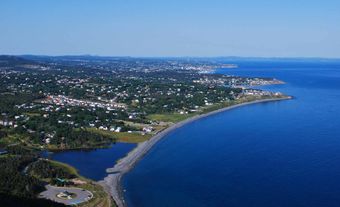Bonavista, NL, incorporated as a town in 1964, population 3589 (2011c), 3764 (2006c). The Town of Bonavista is located near Cape Bonavista on Newfoundland's northeast coast. Its name may have come from the Italian O Buon Vista ("Oh happy sight"), attributed to John Cabot,
Bonavista, one of the oldest communities in North America, was established on a flat, rocky plain southwest of the cape in the late 1500s. Settled by English West Country fish merchants, it was attacked on several occasions by the French; the cape became the northeastern terminus of the French shore. In 1726 the Church of England built in Bonavista what is claimed to be Newfoundland's first school. Bonavista was from its founding the major fishing centre of Bonavista Bay and was later important in the Labrador fishery and seal hunt.
In the 20th century it became a major fish-producing centre. The cod moratorium put in place in the early 1990s had a dramatic effect on the town, putting many people out of work. The crab fishery now supports this sector of the economy. Bonavista has remained a regional social services, transportation and marine services centre, although its importance as a port has declined with the increase in land-based transportation. Tourism is a growing sector as the town has many historical resources. Ryan Premises (a national historic site designated in 1987) is the restored premises and commercial space of salt-cod merchants Michael and James Ryan. The Cape Bonavista Lighthouse and Mockbeggar Plantation are provincial historic sites. There is also a replica of the Matthew, John Cabot's ship.

 Share on Facebook
Share on Facebook Share on X
Share on X Share by Email
Share by Email Share on Google Classroom
Share on Google Classroom

